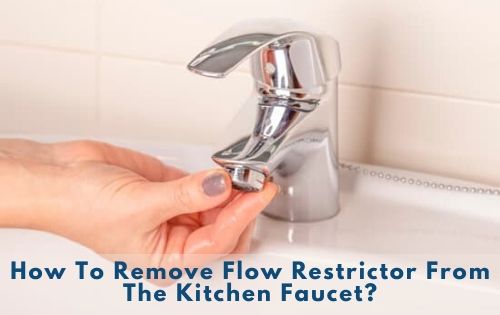A leaky kitchen faucet can be quite frustrating, not to mention costly in terms of wasted water and higher water bills. However, fixing a leaky kitchen faucet is not as difficult as it may seem, and it can be done with some basic tools and a little bit of know-how.
To fix a leaky kitchen faucet, start by turning off the water supply to the faucet. Disassemble the faucet and inspect the components, such as the O-rings and cartridge, for damage. Replace any damaged components, and reassemble the faucet. Turn the water supply back on and test the faucet for leaks.
Prevent future leaks by maintaining the faucet regularly and replacing worn-out components promptly.

Table of Contents
- 1 Step-By-Step Guide For Fixing A Leaky Kitchen Faucet
- 1.1 1. Diagnosing The Problem.
- 1.2 2. Turning Off The Water Supply.
- 1.3 3. Disassembling The Faucet.
- 1.4 4. Inspecting The Faucet Components.
- 1.5 5. Replacing the O-rings.
- 1.6 6. Replacing The Cartridge.
- 1.7 7. Reassembling The Faucet.
- 1.8 8. Turning The Water Supply Back On.
- 1.9 9. Testing The Faucet.
- 1.10 10. When To Call A Professional?
- 2 What Causes A Kitchen Faucet To Leak?
- 3 What Causes A Faucet To Drip?
- 4 How Do You Fix A Leaky Kitchen Faucet With Two Handles?
- 5 How To Fix Leaky Kitchen Faucet Single Handle?
- 6 How To Prevent Future Leaks?
- 7 Final Thoughts: How To Fix A Leaky Kitchen Faucet?
- 8 FAQs (Frequently Asked Questions).
- 8.1 Why Does My Faucet Drip After I Turn It Off?
- 8.2 How Do You Temporarily Stop A Leaky Faucet?
- 8.3 What Tools Do I Need To Fix A Leaky Kitchen Faucet?
- 8.4 How Do I Know If I Need To Replace The O-Rings Or Cartridges?
- 8.5 Can I Fix A Leaky Faucet Myself, Or Do I Need To Call A Professional Plumber?
- 8.6 How Long Does It Take To Fix A Leaky Kitchen Faucet?
Step-By-Step Guide For Fixing A Leaky Kitchen Faucet
Here is the step-by-step guide to fixing your faucet problem in 9 ways. They are:
- First, diagnose the problem.
- After that, turn off the water supply.
- Disassemble the faucet.
- Inspect the faucet components.
- Replace the O-rings.
- Replace the cartridge.
- Reassemble the faucet.
- Turn the water supply back on.
- Test the faucet.
- Finally, if needed, call a professional.
Also Read – How To Fix A Spinning Faucet Handle?
1. Diagnosing The Problem.
The first step in fixing a leaky kitchen faucet is to determine the cause of the leak. There are a few common reasons why a kitchen faucet might leak, including worn-out O-rings, damaged cartridges, loose components, and corroded valve seats.
2. Turning Off The Water Supply.
Before disassembling the faucet, you need to turn off the water supply to the faucet. Look for the shut-off valve underneath the sink and turn it clockwise until it stops. If there is no valve, turn off the main water supply to your home.
3. Disassembling The Faucet.
Before you can inspect and repair a leaky kitchen faucet, you need to disassemble it. Here’s how to do it:
- Turn Off The Water Supply: Before you begin disassembling the faucet, you need to turn off the water supply to the sink. Look for the shut-off valve under the sink and turn it clockwise to shut off the water.
- Remove The Handle: The handle is part of the faucet that you use to turn the water on and off. Depending on the type of faucet you have, you may need to remove a screw, cover plate, or decorative cap to access the handle. Once you’ve done that, use a screwdriver or Allen wrench to remove the handle.
- Remove The Escutcheon: The Escutcheon is the decorative plate that covers the base of the faucet. Use a screwdriver to remove the screws that hold the escutcheon in place. Once the screws are removed, you should be able to lift the escutcheon off the faucet.
- Remove The Retaining Clip Or Nut: Depending on the type of faucet you have, there may be a retaining clip or nut that holds the cartridge or valve in place. Use pliers or a wrench to remove the clip or nut.
- Pull Out The Cartridge Or Valve: Once the retaining clip or nut is removed, you should be able to pull the cartridge or valve out of the faucet body. If it’s difficult to remove, you can use pliers or a cartridge puller to help you.
- Inspect The Components: With the faucet disassembled, you can now inspect the components for signs of wear or damage. This is a critical step in determining the cause of the leak and identifying any parts that need to be replaced.
When disassembling the faucet, be sure to keep track of the components and the order in which they were removed. This will make reassembly much easier. And if you’re not comfortable with disassembling the faucet yourself, it’s best to hire a professional plumber to do the job.
4. Inspecting The Faucet Components.
With the faucet disassembled, it’s time to inspect the components for any signs of wear or damage. This is a critical step in determining the cause of the leak and identifying any parts that need to be replaced. Here are the components you should inspect:
- Cartridge or Valve: This is the part of the faucet that controls the water flow. Inspect the cartridge or valve for any cracks, chips, or other damage. If the component is damaged, you will need to replace it with a new one.
- O-rings: These are small rubber rings that seal the cartridge or valve in place. Inspect the O-rings for any signs of wear or damage. If the O-rings are damaged, they can cause leaks and will need to be replaced.
- Washers: These are small metal discs that control the water flow. Inspect the washers for any signs of wear or damage. If the washers are worn or damaged, they can cause leaks and will need to be replaced.
- Springs: These small metal coils are located under the washers and help control the water flow. Inspect the springs for any signs of wear or damage. If the springs are worn or damaged, they can cause leaks and will need to be replaced.
- Seats: These are the flat surfaces that the washers press against to stop the water flow. Inspect the seats for any signs of wear or damage. If the seats are worn or damaged, they can cause leaks and will need to be replaced.
When inspecting these components, be sure to look for any signs of wear or damage. Even small cracks or chips can cause leaks and will need to be addressed. If you’re not sure what you’re looking for, consult the manufacturer’s instructions or seek the advice of a professional plumber.
5. Replacing the O-rings.
If you’ve determined that the O-rings are the cause of the leak, replacing them is a relatively easy fix. Here’s how to do it:
- Remove The Old O-rings: Use a small screwdriver or pick to remove the old O-rings from the faucet body. Be careful not to scratch or damage the surface of the faucet.
- Clean The Faucet Body: Before installing the new O-rings, it’s important to clean the faucet body to remove any debris or residue. Use a clean cloth and some rubbing alcohol to wipe down the surface.
- Install The New O-Rings: Slide the new O-rings onto the stem of the cartridge or valve. Be sure to position them in the correct location, as indicated by the marks left by the old O-rings.
- Reassemble The Faucet: Once the new O-rings are in place, it’s time to reassemble the faucet. Follow the steps outlined in the previous section to put the faucet back together.
- Test The Faucet: Once the faucet is reassembled, turn on the water supply and test the faucet for leaks. If there are no leaks, you’re done! If the faucet is still leaking, you may need to inspect the other components and replace any damaged parts.
Replacing the O-rings is a simple and inexpensive fix for a leaky kitchen faucet. However, if you’re not comfortable with this type of repair, it’s best to hire a professional plumber to do the job. They can also inspect the faucet for other potential issues and make any necessary repairs.
6. Replacing The Cartridge.
If the cartridge is the culprit of your leaky kitchen faucet, you’ll need to replace it. Here are the steps to follow:
- Turn Off The Water Supply: Before you start, make sure to turn off the water supply to the faucet. This can usually be done by turning off the valve under the sink.
- Remove The Handle: Use a screwdriver to remove the handle of the faucet. The screw may be located under a cap on the handle.
- Remove The Cartridge: Use a pair of pliers to grip the cartridge and pull it straight out. If it’s stuck, you may need to use a cartridge removal tool.
- Install The New Cartridge: Insert the new cartridge in the same orientation as the old one. Make sure it’s seated firmly and securely.
- Reassemble The Faucet: Once the new cartridge is in place, reassemble the faucet by following the steps outlined earlier.
- Test The Faucet: Turn on the water supply and test the faucet for leaks. If there are no leaks, you’re good to go. If the faucet is still leaking, there may be another issue, and you should consult a professional plumber.
Replacing a cartridge is a bit more complicated than replacing O-rings, but it’s still a task that can be done by the average homeowner with some patience and the right tools.
7. Reassembling The Faucet.
After replacing any faulty components, it’s time to reassemble the faucet. Here are the steps to follow:
- Reinstall The Cartridge: If you have to replace the cartridge, insert the new one in the same orientation as the old one. Make sure it’s seated firmly and securely.
- Install The New O-rings: If you had to replace the O-rings, slide the new ones onto the stem and position them in place.
- Reinstall The Retaining Clip: Place the retaining clip back onto the cartridge stem to hold the cartridge in place.
- Reinstall The Handle: Reattach the handle of the faucet by screwing it back on. Make sure it’s tight but not over-tightened.
- Test The Faucet: Turn on the water supply and test the faucet for leaks. Run both hot and cold water for a few minutes to make sure everything is working properly.
If there are no leaks and the water flow is normal, congratulations! You’ve successfully fixed your leaky kitchen faucet. However, if the faucet is still leaking, there may be another issue that needs to be addressed. In this case, it’s best to consult a professional plumber.
8. Turning The Water Supply Back On.
Now that you have successfully reassembled your faucet and tested it for leaks, it’s time to turn the water supply back on. Follow these steps:
- Close The Faucet: Make sure that the faucet handle is turned off before turning the water supply back on.
- Locate The Water Shutoff Valve: The water shutoff valve is usually located under the sink. Turn it on slowly to allow water to flow back into the faucet.
- Check For Leaks: Once the water supply is back on, check for any leaks around the faucet. If you notice any leaks, turn the water supply back off and repeat the steps to disassemble and reassemble the faucet.
- Run The Water: Turn on the faucet and let the water run for a few minutes to clear out any air in the system.
By following these simple steps, you should have a fully functioning kitchen faucet without any leaks. Remember, it’s important to regularly check your faucet for any signs of leaks or damage to prevent costly repairs in the future.
9. Testing The Faucet.
Once the water is flowing smoothly, test the faucet for leaks. Turn the faucet on and off, and check for any signs of dripping or leaking. If the faucet is still leaking, you may need to repeat some of the previous steps to ensure that all components are properly installed.
10. When To Call A Professional?
While fixing a leaky kitchen faucet is a relatively simple task, there may be some situations where you should call a professional plumber. If you’re unsure about your ability to complete the repair, or if you encounter any unexpected issues during the repair process, it’s always best to call in a professional to avoid causing further damage to your faucet or plumbing system.
Also Read – How To Remove Kitchen Faucet Without Basin Wrench?
What Causes A Kitchen Faucet To Leak?
A kitchen faucet can leak for several reasons like worn-out O-rings, damaged washers, corroded valve seats, loose connections, and worn-out cartridges. Here are some of the most common causes:
- Worn-Out O-rings: O-rings are small rubber gaskets that are used to seal the connections between different parts of the faucet. Over time, they can become worn out and start to leak.
- Damaged Washers: Washers are another component that can wear out over time and cause leaks. They are typically found at the base of the faucet and are responsible for sealing the connection between the faucet and the sink.
- Corroded Valve Seat: The valve seat is the connection point between the faucet and the spout. If it becomes corroded, it can cause leaks around the base of the spout.
- Loose Connections: If any of the connections between the different parts of the faucet become loose, it can cause leaks.
- Worn-Out Cartridge: The cartridge is a component inside the faucet that controls the water flow. If it becomes worn out, it can cause leaks or other issues with the faucet.
“Fixing a leaky faucet is a simple and cost-effective way to save water and prevent further damage to your kitchen sink.” – The Family Handyman
Also Read – 6 Pull-Out Spray Kitchen Faucet Problems
What Causes A Kitchen Faucet Leaking From Neck?
If your kitchen faucet is leaking from the neck, there are a few possible causes like loose connections, damaged O-rings, corroded valve seats, and worn-out washers.
- Loose Connections: Over time, the connections between the faucet and the sink can become loose, causing leaks. Check the connections and tighten them if necessary.
- Damaged O-Ring: The O-ring is a small rubber ring that seals the faucet’s body and neck. If the O-ring is damaged or worn out, water can leak through the neck. To fix this, you’ll need to replace the O-ring.
- Corroded Valve Seat: The valve seat is the connection between the faucet and the spout. If it becomes corroded, it can cause leaks. In this case, you’ll need to remove the spout and replace the valve seat.
- Worn-Out Washer: The washer is a small rubber disc that sits inside the faucet and controls the flow of water. If it becomes worn out or damaged, it can cause leaks. To fix this, you’ll need to replace the washer.
To fix a kitchen faucet leaking from the neck, you’ll need to take the following steps:
- Turn Off The Water Supply: Locate the valves under the sink and turn off the water supply by turning the valve handle clockwise.
- Disassemble The Faucet: Carefully disassemble the faucet by removing the spout and any other components.
- Inspect The Components: Check the O-ring, valve seat, and washer for signs of wear and tear. If any of these parts are damaged, they will need to be replaced.
- Replace The Damaged Parts: Replace the damaged parts with new ones of the same size and style. Be sure to use the correct parts for your faucet model.
- Reassemble The Faucet: Reassemble the faucet in the reverse order of the disassembly. Make sure all the parts are snug but not overly tightened.
- Turn On The Water Supply: Turn the valves under the sink counterclockwise to turn the water supply back on.
- Test The Faucet: Turn on the faucet and check for leaks. If the faucet is still leaking, you may need to tighten the connections a little more or repeat the process with new parts.
Also Read – How To Remove Handle From Faucet?
Why Is My Faucet Leaking From The Base And Under The Sink?
If your kitchen faucet is leaking from the base and under the sink, there could be several possible causes.
1. One Common Cause Is A Loose Or Worn-Out Mounting Nut: Over time, the mounting nut that secures the faucet to the sink can become loose, allowing water to leak out from the base of the faucet. In addition, the mounting nut can also become worn out or damaged, which can also cause leaks.
2. Another Possible Cause Of A Faucet Leaking From The Base And Under The Sink Is A Damaged O-Ring. O-rings are small rubber rings that are used to create a watertight seal between the various components of the faucet. If the O-ring becomes damaged or worn out, it can cause water to leak out from the base of the faucet.
3. Finally, A Damaged Or Worn-Out Cartridge Can Also Cause A Kitchen Faucet To Leak From The Base And Under The Sink. The cartridge is part of the faucet that controls the flow of water. And if it becomes damaged or worn out, it can cause water to leak out from the base of the faucet.
“Learning how to fix a leaky kitchen faucet is a handy skill that can save you time and money in the long run.” – Bob Vila
To fix a kitchen faucet that is leaking from the base and under the sink:
- You will need to first turn off the water supply to the faucet.
- Next, you will need to disassemble the faucet and inspect the various components for damage or wear.
- Depending on the cause of the leak, you may need to replace the mounting nut, O-ring, or cartridge.
- Once you have replaced the damaged component, you can reassemble the faucet and turn the water supply back on.
Also Read – Tighten A Loose Moen Single Handle Kitchen Faucet & Base
What Causes A Faucet To Drip?
A faucet can drip due to several reasons, including worn-out parts, loose or damaged washers, damaged valve seats, and corroded pipes. Over time, the parts inside the faucet can wear out or become damaged, causing water to leak through the faucet. The washer, which is responsible for creating a seal to prevent water from leaking, can become loose or damaged, causing water to drip through the spout.
Also, the valve seat, which connects the faucet to the spout, can become damaged due to mineral deposits or corrosion, allowing water to leak through. Corroded pipes can also cause a faucet to drip, as the corrosion can damage the seals and cause water to leak through the faucet. It is important to address a dripping faucet promptly to prevent water waste and potential damage to your plumbing system.
What Are The Three Most Common Causes Of Leaky Dripping Faucets?
The three most common causes of leaky dripping faucets are worn-out washers, worn-out O-rings, and corroded valve seats.
- Worn-Out Washers: The washer is a small rubber gasket located at the base of the faucet that seals the connection between the faucet and the sink. Over time, the washer can become worn out or damaged, which can cause leaks and dripping.
- Worn-Out O-rings: O-rings are small rubber gaskets used to seal the connections between different parts of the faucet. If they become worn out, they can cause leaks and dripping.
- Corroded Valve Seat: The valve seat is the connection point between the faucet and the spout. If it becomes corroded, it can cause leaks and dripping around the base of the spout.
By identifying the cause of the leak, you can determine the best way to fix it and prevent it from happening again in the future. In most cases, replacing the worn-out washers or O-rings, or cleaning or replacing the valve seat can fix the problem.
How Do You Fix A Leaky Kitchen Faucet With Two Handles?
Fixing a leaky kitchen faucet with two handles is generally a straightforward process. Here are the steps you can follow:
- Turn Off The Water Supply: Locate the valves under the sink and turn off the water supply by turning the valve handle clockwise.
- Remove The Handles: Use a screwdriver to remove the screw that holds the handles in place. Gently lift the handles off the faucet.
- Remove The Nuts And Bolts: Use an adjustable wrench to loosen and remove the nuts and bolts that secure the faucet to the sink.
- Disassemble The Faucet: Carefully disassemble the faucet by removing the spout and any other components.
- Inspect The Components: Check the washer, O-ring, and valve seat for signs of wear and tear. If any of these parts are damaged, they will need to be replaced.
- Replace The Damaged Parts: Replace the damaged parts with new ones of the same size and style. Be sure to use the correct parts for your faucet model.
- Reassemble The Faucet: Reassemble the faucet in the reverse order of the disassembly. Make sure all the parts are snug but not overly tightened.
- Turn On The Water Supply: Turn the valves under the sink counterclockwise to turn the water supply back on.
- Test The Faucet: Turn on the faucet and check for leaks. If the faucet is still leaking, you may need to tighten the nuts and bolts a little more.
How To Fix Leaky Kitchen Faucet Single Handle?
A leaky kitchen faucet with a single handle is a common plumbing problem that can be fixed with some basic tools and a little know-how. Here are the steps to fix a leaky kitchen faucet with a single handle:
- Turn Off The Water Supply: Before you start fixing the faucet, turn off the water supply to the faucet. You can do this by turning off the shut-off valve located under the sink.
- Remove The Handle: Use a screwdriver to remove the screw that holds the handle in place. Once the screw is removed, gently pull the handle off the faucet.
- Remove The Cartridge: Use a pair of pliers to remove the cartridge. The cartridge is the part of the faucet that controls the flow of water. Once the cartridge is removed, inspect it for any signs of damage or wear.
- Replace The Cartridge: If the cartridge is damaged or worn, replace it with a new one. Make sure the replacement cartridge is the same size and model as the original.
- Reassemble The Faucet: Once the new cartridge is in place, reassemble the faucet in the reverse order you disassembled it.
- Turn On The Water Supply: Turn the water supply back on and test the faucet for leaks. If there are no leaks, your faucet is fixed.
Also Read – How To Remove Flow Restrictor From The Kitchen Faucet?
How To Prevent Future Leaks?
Once you have fixed your leaky kitchen faucet, it’s important to take steps to prevent future leaks from occurring. Here are some tips to help keep your faucet in good condition:
- Regularly inspect your faucet for any signs of wear and tear. Replace any damaged parts, such as O-rings or cartridges, before they cause a leak.
- Be gentle when using your faucet. Don’t force the handle or yank on the spout. This can cause damage to the internal components and lead to leaks.
- Harsh chemicals, such as drain cleaners, can damage the internal components of your faucet. Use gentle, non-toxic cleaners to clean your faucet instead.
- If you are unsure of how to fix a leaky faucet or if you have tried to fix it yourself and it still leaks, consider hiring a professional plumber. They can ensure that your faucet is properly installed and functioning.
Final Thoughts: How To Fix A Leaky Kitchen Faucet?
Fixing a leaky kitchen faucet is a task that can be completed by most homeowners with basic tools and some knowledge of plumbing. By following the steps outlined in this guide, you can diagnose the cause of the leak, replace any damaged components, and restore your faucet to full working order. With proper maintenance, you can prevent future leaks and extend the life of your kitchen faucet.
Also Read – How To Clean Plastic Kitchen Sink?
FAQs (Frequently Asked Questions).
-
Why Does My Faucet Drip After I Turn It Off?
If your faucet drips after you turn it off, it may be due to a worn-out washer, loose parts, or a damaged valve seat. It is best to address the issue promptly to prevent water waste and potential damage to your plumbing system.
-
How Do You Temporarily Stop A Leaky Faucet?
You can temporarily stop a leaky faucet by turning off the water supply to the faucet or placing a bucket under the faucet to catch the water.
-
What Tools Do I Need To Fix A Leaky Kitchen Faucet?
To fix a leaky kitchen faucet, you’ll need a few basic tools including an adjustable wrench, pliers, a screwdriver, an Allen wrench, and a cartridge puller. Some models may require additional tools such as a basin wrench or a faucet seat wrench.
-
How Do I Know If I Need To Replace The O-Rings Or Cartridges?
If your kitchen faucet is leaking from the base of the spout, you likely need to replace the O-rings. If it’s leaking from the handle, you may need to replace the cartridge. If you’re unsure which component is causing the leak, try replacing the O-rings first as they are typically easier and less expensive to replace.
-
Can I Fix A Leaky Faucet Myself, Or Do I Need To Call A Professional Plumber?
Fixing a leaky kitchen faucet is a relatively simple task that can be completed by most homeowners with basic tools and some knowledge of plumbing. However, if you’re unsure about your ability to complete the repair, it’s always best to call in a professional to avoid causing further damage.
-
How Long Does It Take To Fix A Leaky Kitchen Faucet?
The time required to fix a leaky kitchen faucet can vary depending on the cause of the leak and the extent of the damage. In general, a simple repair such as replacing the O-rings or tightening a loose connection can be completed in under an hour.
More complex repairs, such as replacing a damaged cartridge, may take several hours.
Katrina Smith is a seasoned expert with over 25 years of experience in all things related to cooking and the kitchen. As an avid cook and kitchen enthusiast, she is passionate about sharing her knowledge and expertise on cookware, kitchen appliances, kitchen tips, and kitchen staples.
Through her articles and reviews, Katrina aims to inspire and help others improve their cooking skills, experiment with different ingredients, and invest in quality cookware and appliances.

![How To Unclog A Sink Clogged With Coffee Grounds? [3 Effective Ways] 3 How-to-Unclog-a-Sink-Clogged-With-Coffee-Grounds](https://www.kitchensity.com/wp-content/uploads/2020/06/How-to-Unclog-a-Sink-Clogged-With-Coffee-Grounds.jpg)


![Best Insulation Under The Kitchen Sink [3 Top Insulations] 6 Best Insulation Under The Kitchen Sink](https://www.kitchensity.com/wp-content/uploads/2023/04/Best-Insulation-Under-The-Kitchen-Sink.jpg)

